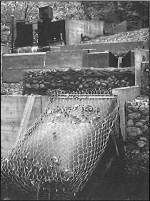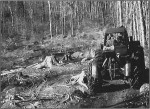By Timothy J. Fahey and G.E. Likens
Originally established by the U.S. Forest Service in 1955 as a center for hydrologic research in New England, the Hubbard Brook Experimental Forest became widely known as a site for ecosystem studies, originating the small watershed approach to quantify element cycles and initiating the Hubbard Brook Ecosystem Study (HBES) in 1960. Today, the HBES continues to probe the complex interactions between biological systems and their physical-chemical environment through an integrated suite of long-term monitoring, plot-level and watershed-scale manipulations, and conceptual and quantitative models. Entering the Network in 1987, the Hubbard Brook (HBR) LTER project has contributed greatly toward attaining the overall goal of the HBES: to develop an understanding of ecological processes governing the structure and function of the northern hardwood forest ecosystem and associated aquatic ecosystems in order to provide a scientific basis for their management.
The theme of the ongoing HBR-LTER project is ecosystem response to natural and anthropogenic disturbances. Recognizing that the dynamics of an ecosystem scarcely can be understood in the absence of comprehensive knowledge of the historical and contemporary suite of disturbances to which it is exposed, we have continued to evaluate disturbance effects on biotic communities and on energy flow and element cycles. Most recently, these efforts have been highlighted by our attempts to synthesize current knowledge o the biogeochemistry of macronutrient elements in the HBEF watershed-ecosystems. The cycles of these elements have been altered on a region-wide scale by anthropogenic disturbance, especially land use in the form of forest harvest and air pollution in the form of atmospheric acid deposition. Exploration of the interactions between biogeochemical cycles and these disturbances over long time scales has been possible at HBR because of the long-term continuity of the research program.
The experimental watersheds at Hubbard Brook are situated on moderate to steep slopes near the upper elevation limit of the hardwood forest in the White Mountains of New Hampshire. Soils are acidic, well-drained spodosols with a thick organic horizon, and soil depth decreases up the hillslope. The HBEF was heavily logged between 1909-1917, and although the forest exhibited high rates of biomass accumulation through the late 1970s, in recent years net biomass accumuation has declined almost to zero.
Calcium Cycling at Hubbard Brook
The combination of naturally base-poor soils, high deposition of anthropogenically-derived acids and periodically accelerated removal of bases associated with forest harvest would be expected to make the Hubbard Brook ecosystem susceptible to excessive depletion of soil base cations, especially calcium (Federer et al. 1989). In fact, a quantitative interpretation of our records of precipitation, soil and streamwater chemistry strongly suggests that ecosystem recovery in response to decreases in acid deposition may be delayed significantly (Likens et al. 1996, in press).
Reductions in pollution emissions of SO2 and consequent decreases in deposition of strong acids followed the passage of the Clean Air Act in 1970, but at HBEF these reductions have been accompanied by declining deposition of strong-base cations (CB), especially calcium. Coincident reductions in streamwater concentrations of strong acids and strong bases since 1970 have resulted in a lack of response of pH and ANC of surface waters across the northeastern region. To evaluate the possible implications of historical and projected changes in atmospheric deposition, Likens et al. (1996) estimated the suite of ecosystem sources and sinks of calcium for the Hubbard Brook forest since 1940. These budgetary calculations suggest that an interval of high net losses of calcium from the soil exchange complex occurred during the peak of acid deposition (1960 and 1970s) when the Hubbard Brook forest was rapidly accumulating biomass (and calcium). Together with the recently reduced inputs of CB in bulk deposition, these net losses may be adversely affecting calcium supply to the trees. We have measured marked declines in calcium concentrations in organic soil horizons since 1970, stemwood concentrations have declined steadily since peaking in the 1960s, and on the shallowest soils foliar calcium also appears to be affected. We have observed unusually high mortality of sugar maple in the upper hardwood zone in the Hubbard Brook forest where soil calcium pools are smallest, and foliage Ca concentrations for sugar maple and yellow birch in this zone have been consistently lower by over 50% than lower on the hillslope.
Has forest production and health at Hubbard Brook been declining because of limitation by nutrient base cations? We recently implemented a plot-level soil chemical manipulation study on these upper slopes at HBEF to address this question and to further evaluate the base cation cycling patterns and their responses to inputs and losses of base cations. The results of this ongoing study will aid in the design of a watershed-level chemical manipulation that will allow us to take advantage of our small watershed approach and to examine landscape-level variations in ecosystem response to chemical perturbations.
Potassium Cycling
The importance of landscape-level patterns in explaining whole watershed behavior were particularly evident in our integrative analysis of the cycle of potassium at HBEF (Likens et al 1994) and its response to large-scale disturbance by forest harvest (Romanowicz et al. 1996). In the upper reaches of the forested watersheds, concentrations of K in streamwater are relatively high (12 ,mol/L) and seasonally invariant, whereas lower in the catchment concentrations are lower (4-5 ,mol/L) and show a pronounced decline during the growing season. This pattern has been attributed primarily to systematic variation in soil properties across the watersheds. Soils at high elevation are rich in organic matter and hence exchangeable K, and high streamwater K is maintained despite the seasonal vegetation uptake sink. At lower elevations organic matter levels and exchangeable K pools are much lower in mineral soil horizons leading to lower average K concentrations in streams.
The seasonal variations at lower elevations appear to result largely from changes in hydrologic flowpaths, with higher concentrations in the late fall, winter and spring when the local water table rises closer to the surface and water migrates laterally through the porous and more K-rich surface horizons (Likens et al. 1994). During the growing season, transpiration lowers the water table and water flows mostly through deeper soil layers. After clearcutting, K concentrations in streams rise markedly for a few years until vegetation is re-established; however, K in streams remains elevated (by roughly 2-fold) for many years thereafter whereas NO3 concentrations are reduced nearly to zero 4 years after clearcutting. This unexpected behavior of K appears to be explained in part by increases in soil exchangeable K pools that resulted from accelerated release from detrital pools (dead roots and forest floor). Again, the behavior of K displays a landscape- level pattern that is in accord with the aforementioned soil chemical and hydrologic mechanism of control of streamwater K concentration. For example, in the recovery phase after cutting annual variation in streamwater K is accentuated particularly in the lower part of the watershed where the soils and glacial till are deepest and the shifts in hydrologic flowpaths most prominently affect stream chemistry.
Our greatest challenge in synthesizing macronutrient cycles is the case of nitrogen because of its complex transformations. By integrating the processes and patterns of N cycling over the long period of biogeochemical study at HBEF we hope to contribute to a better fundamental understanding of the behavior of this important nutrient and pollutant (and its interactions with other elements) so that a sound scientific basis for management of N in regional ecosystems can be established. This research continues the tradition of basic and applied biogeochemical studies of the Hubbard Brook Ecosystem Study and the HBR-LTER project.
For more information:
Marian T. Hovencamp,
607/255-2809
mth6@cornell.edu;
or Timothy J. Fahey,
607/255-5470,
tFahey@LTERnet.edu

 Enlarge this image
Enlarge this image
